Documents: Go to download!
- User Manual - (English)
- Quick Start Guide - (English)
- Using the On-Screen Menu
- Using the USB Media Player 4
- Troubleshooting
Table of contents
User Manual Smart TV
Using the On-Screen Menu
NAVIGATING THE ON-SCREEN MENU

While navigating the on-screen menu, you can press the BACK button at any time to return to the previous menu screen. The EXIT button will close the on-screen menu.
CHANGING THE INPUT SOURCE
External devices such as DVD players, Blu-ray Players, and video game consoles can be connected to your TV. To use one of these devices with your TV, you must first change the input source using the Input menu.
To change the input source:
- Press the INPUT button on the remote. The Input menu is displayed.
- Use the Up/Down Arrow buttons or the INPUT button on the remote to highlight the input you wish to view and press OK. The selected input is displayed.
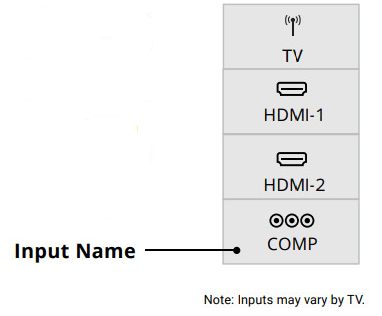
You can change the input names that appear on the Input menu to make your devices easy to recognize. See Renaming Devices on the Input Menu for more information.
CHANGING THE SCREEN ASPECT RATIO
The TV can display images in five different modes: Normal, Stretch, Panoramic, Wide, and Zoom. Each mode displays the picture differently. Some programs have black bars on the top or sides of the picture so that the picture keeps its original shape. Examples include wide-screen movies and older television programs.
To change the screen aspect ratio:
- Press the WIDE button on the remote.
- Use the Arrow buttons to highlight the aspect ratio you wish to view and press OK .
- Normal preserves the content’s original aspect ratio and size.
- Panoramic stretches a 4:3 aspect ratio picture to the left and right edges of the screen. The center of the image is not stretched, but the sides of the image are extremely stretched. If you are watching widescreen (1.85:1 or 2.35:1) content with black bars on the top and bottom, the black bars will still appear on the top and bottom of the display image.
- Wide stretches a 4:3 aspect ratio picture to the edges of the screen. Since the picture is being stretched, the display image may appear distortedȃfigures appear short and fat. If the program is already formatted for widescreen viewing (1.85:1 or 2.35:1), then black bars will appear on the top and bottom of the display image.
- Zoom expands images evenly in all directions
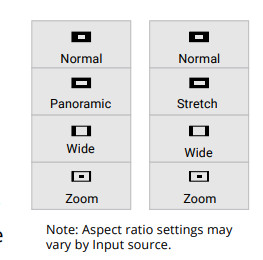
Tip: The aspect ratio cannot be changed for Ultra HD content or for any video content on HDMI-5.
ADJUSTING THE PICTURE SETTINGS
Your TV display can be adjusted to suit your preferences and viewing conditions.
If you’ve changes to the settings for a picture mode, an asterisks appears after its name (see Saving a Custom Picture Mode)
To adjust the picture settings:
- Press the MENU button on the remote. The on-screen menu is displayed.
- Use the Arrow buttons on the remote to highlight Picture and press OK. The PICTURE menu is displayed.
- Use the Arrow buttons on the remote to highlight Picture Mode, then use the Left/Right Arrow buttons to change the picture mode:
- Standard mode sets the picture settings to the default settings.
- Calibrated mode sets the picture settings to values ideal for watching TV in a brightly-lit room.
- Calibrated Dark mode sets the picture settings to values ideal for watching TV in a dark room.
- Vivid mode sets the picture settings to values that produce a brighter, more vivid picture.
- Game mode reduces throughput delays and optimizes the picture settings for displaying game console output.
- Computer mode optimizes the picture settings for displaying computer output.
- Standard picture mode meets Energy Star® requirements. For the best picture, switch to Calibrated mode. Note that Calibrated mode does not meet Energy Star® requirements. Customizing picture settings will change the energy consumption required to operate the TV.

- To manually change each of the picture settings, use the Up/ Down Arrow buttons on the remote to highlight that picture setting, then use the Left/Right Arrow buttons to adjust the setting:
- Auto Brightness Control - The auto brightness control detects the light levels in the room and automatically adjusts the backlight for the best picture.
- Backlight - adjusting the brightness to affect the overall brilliance of the picture. Backlight cannot be adjusted when starting from some picture modes.
- Brightness - adjusting the black level of the picture. When this setting is too low, the picture may be too dark to distinguish details. When this setting is too high, the picture may appear faded or washed out.
- Contrast - Adjusts the white level of the picture. When this setting is too low, the picture may appear dark. When this setting is too high, the picture may appear faded or washed out. If the setting is too high or too low, detail may be disfficult to distinguish in dark or bright areas of the picture.
- Color - Adjusts the intensity of the picture colors.
- Tint - Adjusts the hue of the picture. This setting is useful in adjusting the flesh tones in the picture. If flesh appears too orange, reduce the level of color before adjusting tint.
- Sharpness - Adjusts the edge sharpness of picture elements. It can be used to sharpen non-HD (high definition) content, however, it will not produce detail that does not otherwise exist.
- When you have finished adMusting the picture settings, press the EXIT button on the remote.
ADJUSTING THE AUDIO SETTINGS
To adjust the audio settings:
- Press the MENU button on the remote. The on-screen menu is displayed.
- Use the Arrow buttons on the remote to highlight Audio and press OK. The AUDIO menu is displayed.
- Use the Arrow buttons to highlight the setting you wish to adjust, then press Left/ Right Arrow buttons to change the setting:
- TV Speakers - Turns the built-in speakers On or Off.
- When the TV speakers are set to On, DTS signals cannot be passed through digital audio outputs.
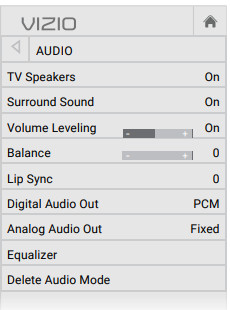
- Surround Sound - Surround sound uses DTS TruSurround™ to deliver an immersive surround sound experience from the TV’s internal speakers. TruSurround completes the entertainment experience by providing deep, rich bass and by delivering crisp details and clear, intelligible dialog. Select On or off.
- Volume Leveling - Volume leveling uses DTS TruVolume™ to maintain consistent volume levels during transitions between program content, AV formats, and input sources. Select On or off. In a few cases, volume leveling may artificially suppress volume increases, making it disfficult to hear dialog or flattening sudden noises. If this occurs, turn volume leveling off.
- Balance - Adjusts the loudness of the audio output from the left and right speakers.
- Lip Sync - Adjusts the synchronization between the display image and the accompanying audio track.
- Digital Audio Out - Changes the type of processing for digital audio out and HDMI ARC output when connected to a home theater audio system. Select Auto, PCM, Dolby D or Bitstream
- You must select Bitstream for audio with more than two channels
- Analog Audio Out - Sets the volume control properties for the RCA connector when connected to a home theater audio system. Select Variable if you are controlling the volume with the TV’s volume controls, or select Fixed if an external audio device (sound bar or AV receiver) will control the volume.
- Equalizer - Adjusts the boost or attenuation of different frequencies using either preset or custom settings. See Changing the Equalizer Settings.
- Delete Audio Mode - Deletes a custom audio mode created using the Equalizer Settings. See Deleting the Custom Audio Mode.
- When you have finished Adjusts the audio settings, press the EXIT button on the remote.
Changing the Equalizer Settings
The graphic equalizer has several pre-set modes and allows you to create one custom mode.
To select a pre-set audio mode:
- Press the MENU button on the remote. The on-screen menu is displayed.
- Use the Arrow buttons on the remote to highlight Audio and press OK. The AUDIO menu is displayed.
- Use the Arrow buttons to highlight Equalizer and press OK. The Audio Mode and equalizer settings screen appears.
- Use the Left and Right Arrow buttons to select an audio mode. The equali]er bars change to reȵect the mode.
- Press the EXIT button on the remote.
To create, modify, or replace the single custom equalizer setting:
- Press the MENU button on the remote. The on-screen menu is displayed.
- Use the Arrow buttons on the remote to highlight Audio and press OK. The AUDIO menu is displayed.
- Use the Arrow buttons to highlight Equalizer and press OK. The Audio Mode and equalizer settings screen appears.
- Use the Left and Right Arrow buttons to select any audio mode as a starting point.
- Use the Arrow buttons to highlight a frequency and then press OK.
- Use the Up and Down Arrow buttons to adjust the boost (up) and attenuation (down) for the frequency.
- Use the Left and Right Arrow buttons to select another frequency, if desired, and adjust it.
- Press the EXIT button on the remote.
Deleting the Custom Audio Mode
To delete the custom audio mode that has been created:
- Press the MENU button on the remote. The on-screen menu is displayed.
- Use the Arrow buttons on the remote to highlight Audio and press OK. The AUDIO menu is displayed.
- Use the Arrow buttons to highlight Delete Audio Mode and press OK. The TV displays, “To delete the user created custom audio mode, select the Delete button.”
- Highlight Delete and press OK.
- Press the EXIT button on the remote.
SETTING TIMERS
Setting the Timer
When activated, the TVȇs timer will turn the TV off after a set period of time.
- Press the MENU button on the remote. The on-screen menu is displayed.
- Use the Arrow buttons on the remote to highlight Timers and press OK. The TIMERS menu is displayed.
- Use the Left/Right Arrow buttons on the remote to highlight the period of time after which you want the TV to sleep: 30, 60, 90, 120, or 180 minutes. If you don’t want the sleep timer to activate, change the setting to Off.
- When you have finished setting the sleep timer, press the EXIT button on the remote.

Enabling the Screen Saver
If there is no on-screen content or static content when audio is streaming, the backlight is turned o , saving energy. You can set the time before the screen saver begins.
To set the Screen Saver:
- From the TIMERS menu, use the Up/Down Arrow buttons on the remote to highlight Screen Saver.
- Use the Left/Right Arrow buttons on the remote to change the time before the screen saver begins. If you don’t want the screen saver to be active, change the setting to Off. Otherwise, select 2, 10, or 20 minutes.
- When you have finished setting the screen saver time, press the EXIT button on the remote.
To Exit the Screen Saver Press any button other than the Volume and Mute buttons on the remote to exit the screen saver.
Blanking the Screen
You can blank the screen while there is audio streaming. This feature helps save energy and the life of the screen.
To blank the screen:
1. From the TIMERS menu, use the Up/Down Arrow buttons on the remote to highlight Blank Screen and press OK.
To Exit the Blank Screen: Press any button other than the Volume and Mute buttons on the remote to exit the blank screen.
USING THE NETWORK CONNECTION MENU
Your TV is Internet-ready, featuring both an Ethernet port and built-in high-speed Wireless-N.
Connecting to a Wireless Network
To connect to a wireless network whose network name (SSID) is being broadcast:
If your TV is connected to a network with an Ethernet cable, you will not see the wireless network connection menu. You must disconnect the Ethernet cable to set up a wireless network connection.
- Press the MENU button on the remote. The on-screen menu is displayed.
- Use the Arrow buttons on the remote to highlight Network and press OK. The NETWORK menu is displayed.
- If you do not see your wireless network displayed, highlight More Access Points and press OK. The WIRELESS ACCESS POINTS menu, which is a list of available wireless networks, is displayed.
- Highlight the name of your wireless network (this is the network’s SSID) and press OK.
- Using the on-screeen keyboard, enter your network’s password, then highlight Connect and press OK.
- Press the EXIT button on the remote.

Changing the Manual Setup Settings
Advanced users can fine-tune the network settings using the Manual Setup feature.
To change advanced network settings:
- From the NETWORK menu, highlight Manual Setup and press OK. The MANUAL SETUP menu is displayed.
- To change the settings manually, use the Arrow buttons on the remote to highlight DHCP and then use the Left/Right Arrow buttons to change the setting to Off.
- Use the Arrow and OK buttons to adjust each setting:
- IP Address - The IP address assigned to the TV.
- Subnet Mask - The subnet Exit 2D
- Default Gateway - Your network’s default gateway address.
- Pref. DNS Server - Your preferred domain name server address.
- Alt. DNS Server - Your alternate domain name server address.
- Use the Arrow buttons on the remote to highlight Save and press OK.
- Press the EXIT button on the remote.
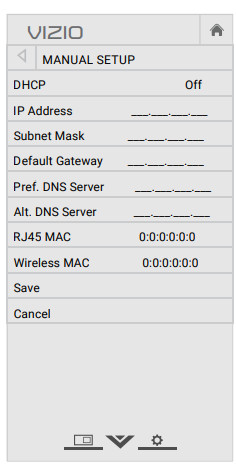
Connecting to a Hidden Network
To connect to a wireless network whose network name (SSID) is not being broadcast:
- From the NETWORK menu, highlight Hidden Network and press OK. The ENTER ACCESS POINT NAME screen is displayed.
- Using the on-screen keyboard, enter your network’s name (SSID), then highlight Connect and press OK
- Using the on-screen keyboard, enter your network’s password, then highlight Connect and press OK.
- Press the EXIT button on the remote.
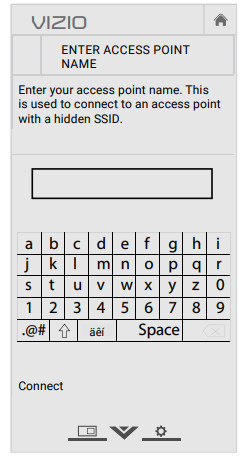
SETTING UP CHANNELS
You can use the TV’s Channels menu to:
- Select a Channel Source
- Find Channels
- Select channels to skip
- Analog Audio
- Digital Audio
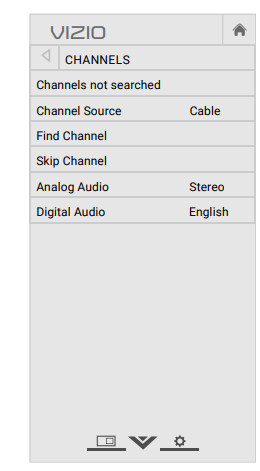
Selecting a Channel Source
Antenna (Over-the-air) or Cable (Out-of-the-wall) connections.
- From the CHANNELS menu, highlight Channel Source and press OK. The CHANNEL SOURCE menu displays.
- Highlight Antenna or Cable and press OK. Press EXIT.
Scanning for Channels
The TV may need to scan for channels before it can display programs and their associated information. A channel scan is required for free over-the-air channels (using an antenna) and cable channels from an out-of-the-wall connection (without a cable box). Moving the TV to an area with different channels requires the TV to scan for channels again.
To perform an Auto Channel Scan:
- From the CHANNELS menu, highlight Find Channels, and press OK. The auto channel scan begins.
- Wait until the channel scan is 100% complete. Highlight Done and press OK.
- Press the EXIT button on the remote.
If the channel scan is canceled, the channels that were already discovered are retained. A new channel scan will clear all channels.

LISTENING TO ALTERNATE AUDIO
Changing the Analog Audio Language
Some analog over-the-air (free) and cable channels broadcast programs in more than one language. The TV’s Analog Audio feature allows you to listen to audio in an alternate language using Secondary Audio Programming (SAP).
Not all programs are broadcast in SAP. The Analog Audio Language feature only works when the program being viewed is being broadcast with Secondary Audio Programming.
To use the Analog Audio feature:
- From the CHANNELS menu, highlight Analog Audio and press OK. The ANALOG AUDIO menu is displayed.
- Select Stereo, SAP (secondary audio programming), or Mono. Press OK.
- Press the EXIT button on the remote.
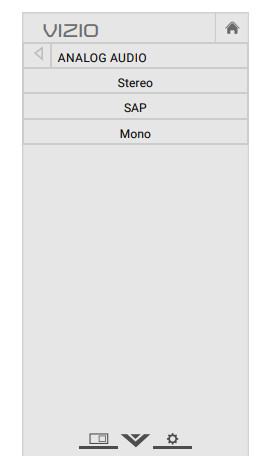
To use the Digital Audio feature:
- From the CHANNELS menu, highlight Digital Audio and press OK. The DIGITAL AUDIO menu is displayed.
- Select your preferred language: English, Spanish/Video Description or French. Press OK.
- Press the EXIT button on the remote.
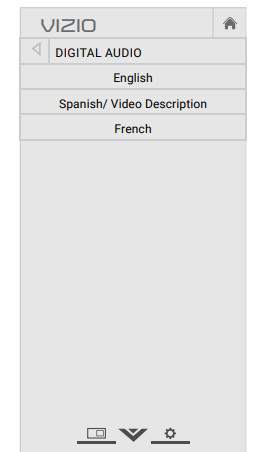
SETTING UP CLOSED CAPTIONING
Your TV can display closed captions for programs that include them. Closed captions display a transcription of a program’s dialogue.
If the program you are viewing is not being broadcast with closed captions, the TV will not display them.
The Closed Captions menu does not appear when an HDMI or Component input is selected
To activate or deactivate closed captions:
- Press the MENU button on the remote. The on-screen menu is displayed.
- Use the Arrow buttons on the remote to highlight Closed Captions and press OK. The CLOSED CAPTIONS menu is displayed.
- Use the Arrow buttons on the remote to highlight Closed Captions and then use the Left/ Right Arrow buttons to select On or off.
- Use the Arrow buttons on the remote to highlight either Analog or Digital Closed Captions.
- Use the Left/Right Arrow buttons on the remote to select the caption channel you wish to display, then press EXIT.
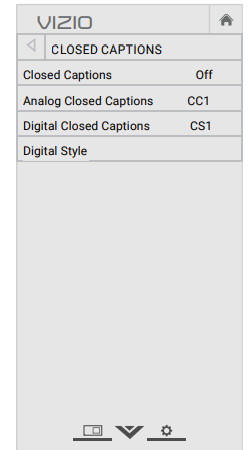
Changing the Appearance of Digital Closed Captions
Digital closed captions can be displayed according to your preference. See the diagram on the next page for an explanation of the parts of the closed caption area.
To change the appearance of digital closed captions:

- From the CLOSED CAPTIONS menu, use the Arrow buttons to highlight Digital Style and press OK.
- Use the Left/Right Arrow buttons on the remote to select Custom. The DIGITAL STYLE menu appears as shown.
- Use the Up/Down Arrow buttons on the remote to highlight the setting you wish to change, then use the Left/Right Arrow buttons to change the setting:
- Caption Style - Choose As Broadcast to keep default settings or Custom to manually change each setting.
- Text Style - Change the font used for the closed captioning text.
- Text Size - Make the text larger or smaller.
- Text Color - Change the color of the text.
- Text Opacity - Change the transparency of the text.
- Text Edges - &hange the effects at the edges of the text, such as raising the edges or adding drop shadows.
- Text Edges Color - Change the color of the text edge effects.
- Background Color - Change the color of the background directly behind the text.
- Background Opacity - Change the transparency of the background directly behind the text.
- Window Color - Change the color of the closed captioning box.
- Window Opacity - Change the opacity of the closed captioning box.
- When you are satisfied with the appearance of the closed captions, press the EXIT button on the remote.
Typical choices include:
- Opaque background, transparent window—Only a strip of background appears behind the text, expanding as the text appears. This is the typical "As Broadcast" mode.
- Opaque background and window in the same color—When text appears, the entire line fills with color at once.
In the example below, the closed caption text is green, the background is black, and the window is red.

RENAMING DEVICES ON THE INPUT MENU
You can rename the inputs to make them easier to recognize on the Input menu. For example, if you have a DVD player connected to the Component input, you can rename that input to display “DVD Player.” See Changing the Input Source.
To change the name of an input:
- Press the MENU button on the remote. The on-screen menu is displayed.
- Use the Arrow buttons on the remote to highlight Devices and press OK. The DEVICES menu is displayed.
- Highlight the input device that you want to rename and press OK.
- To use a preset input name:
- a. Highlight the Input Port row and press OK.
- b. Highlight the input name you want to use and press OK.
- —or—
- To enter a custom name:
- a. Enter your custom label using the on-screen keyboard.
- b. Highlight OK and press OK.
- c. The Input Name changes to show the custom name that you created
- When you have finished naming your input, press the EXIT button on the remote.
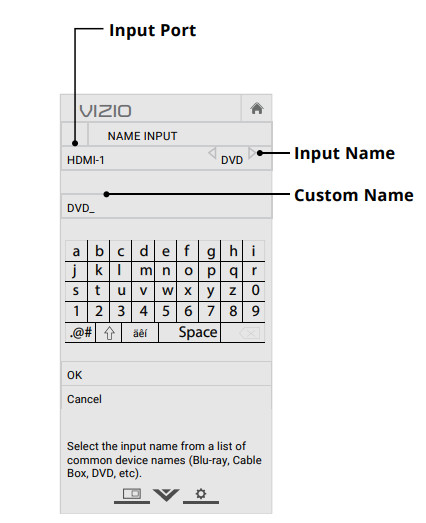
CHANGING THE TV SETTINGS
Using the System menu, you can:
- View system information
- Change the on-screen menu language
- Set time zone and local settings
- Set up parental controls
- Resize the video size when Menu is displayed
- Adjust wide mode
- Adjust the CEC settings
- Adjust when the power indicator is illuminated
- Reset the TV settings & set up administrative controls
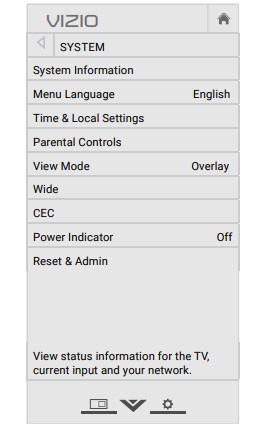
Viewing System Information
To view technical data and status information about your TV and network connection:
- Press the MENU button on the remote. The on-screen menu is displayed.
- Use the Arrow buttons on the remote to highlight System and press OK. The SYSTEM menu is displayed.
- Highlight System Information and press OK.
- Use the Up/Down Arrow buttons to scroll through the system information.
- When you are finished reviewing the system information, press the EXIT button on the remote.
Changing the On-Screen Menu Language
To change the on-screen menu language:
- Press the MENU button on the remote. The on-screen menu is displayed.
- Use the Arrow buttons on the remote to highlight System and press OK. The SYSTEM menu is displayed.
- Use the Arrow buttons on the remote to highlight Menu Language and press OK. The MENU LANGUAGE menu is displayed.
- Highlight your preferred language (English, Español, or Français) and press OK.
- Press the EXIT button on the remote.
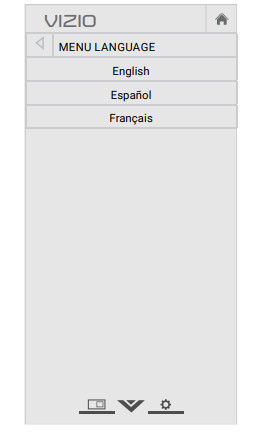
Setting the Time and Local Settings
To ensure the correct time is displayed when you press the INFO button, set the TV’s time zone:
- Press the MENU button on the remote. The on-screen menu is displayed.
- Use the Arrow buttons on the remote to highlight System and press OK. The SYSTEM menu is displayed.
- Use the Arrow buttons on the remote to highlight Time & Local Settings and press OK. The menu headed by the local date and time is displayed.
- Highlight Time Zone and press OK. The TIME ZONE menu is displayed.
- Highlight your time zone and press OK.
- Highlight Daylight Saving Time and press OK. The DAYLIGHT SAVING TIME menu is displayed. Choose On if it is currently Daylight Savings Time, off if it is Standard Time, or Auto to have the system automatically detect Daylight Savings Settings.
- Press the EXIT button on the remote.
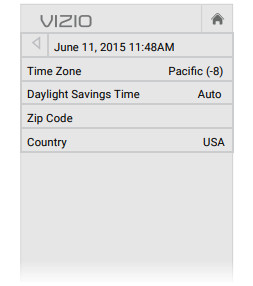
Using the Parental Controls
The TV’s parental controls allow you to prevent the TV from displaying certain channels or programs without a password. The Parental Controls menu only appears when:
- You are using the tuner to receive your TV signals, such as when you are using an antenna for Over-the-Air signals or when connected to cable TV directly from the wall (no cable box).
- You have a device connected using a composite video cable or a coaxial cable, such as a VCR, satellite or cable box, or DVR.
Other devices have their own parental control settings.
Accessing the Parental Controls Menu
To access the Parental Controls menu:
- Press the MENU button on the remote. The on-screen menu is displayed.
- Use the Arrow buttons on the remote to highlight System and press OK. The SYSTEM menu is displayed.
- Use the Arrow buttons on the remote to highlight Parental Controls and press OK.
- Enter your parental PIN. If you have not set a PIN, enter the default, 0000.
The PARENTAL CONTROLS menu is displayed. To set a custom parental passcode, see Changing the Parental Control PIN.
Enabling or Disabling Program Ratings
To manage program content according to its rating, you must enable the Program Rating feature. To enable or disable the Program Rating feature:
- From the PARENTAL CONTROLS menu, highlight Locks and press OK. The LOCKS menu is displayed.
- Select On or off and press OK.
Locking and Unlocking Channels
When a channel is locked, it will be inaccessible. Locking a channel is a good way to prevent children from viewing inappropriate material.
To lock or unlock a channel:
- From the PARENTAL CONTROLS menu, highlight Channel Locks and press OK. The CHANNEL LOCKS menu is displayed.
- Highlight the channel you want to lock or unlock and press OK.
- When a channel is locked, the Lock icon appears
 locked. The channel is not accessible unless the parental PIN is entered.
locked. The channel is not accessible unless the parental PIN is entered. - When a channel is unlocked, the Lock icon appears
 unlocked. The channel is accessible.
unlocked. The channel is accessible.
Blocking and Unblocking Content by Rating
A channel may sometimes broadcast programs that are meant for children, and at other times broadcast programs that are meant for mature audiences. You may not want to block the channel completely using a channel lock, but you may wish to block certain programs from being viewed. When this is the case, you can use the TV’s Rating Block feature to block content based on its rating.
To block or unblock content by its rating:
- From the PARENTAL CONTROLS menu, highlight the content type you want to adjust and press OK:
- For each rating type you want to block or unblock, use the Up/Down and Left/Right Arrow buttons on the remote to highlight the rating type and press OK.
- When the rating type is blocked, the Lock icon appears
 locked. Content with this rating and all higher ratings cannot be viewed.
locked. Content with this rating and all higher ratings cannot be viewed. - When the rating type is unblocked, the Lock icon appears
 unlocked. Content with this rating and all lower ratings can be viewed. If you want to block all unrated content, highlight Block Unrated Shows and use the Arrow buttons on the remote to select On.
unlocked. Content with this rating and all lower ratings can be viewed. If you want to block all unrated content, highlight Block Unrated Shows and use the Arrow buttons on the remote to select On. - When you are finished adMusting the rating level blocks, press the EXIT button on the remote.
Changing the Parental Control PIN
If you use the parental controls, you should change the PIN to prevent children from accessing inappropriate material. To change the parental control PIN:
- From the PARENTAL CONTROLS menu, highlight Change PIN and press OK. The CHANGE PIN menu is displayed.
- In the NEW PIN field, use the Number Pad on the remote to enter your new 4-digit parental control PIN.
- In the CONFIRM PIN field, use the Number Pad on the remote to re-enter your new 4-digit parental control PIN.
- Write down your new parental control PIN and save it in a secure location.
- Press the EXIT button on the remote.
Resetting the Content Locks
To reset the content locks to the factory-default settings:
- From the PARENTAL CONTROLS menu, highlight Reset Locks and press OK. The TV displays, “Select Reset to restore Parental Controls to factory defaults.”
- Highlight Reset and press OK.
USING THE RESET & ADMIN MENU
You can use the TV’s Reset & Admin menu to restore the TV to its factory default settings.
Restoring the TV to Factory Default Settings
All of the on-screen menu settings can be reset to the factory defaults.
If you restore the TV to the factory default settings, all changes you have made to the settings will be lost! This includes any V.I.A. Plus Apps that you have added and any changes you have made to the settings for those Apps.
To restore the TV to its factory default settings:
- Press the MENU button on the remote. The on-screen menu is displayed.
- Use the Arrow buttons on the remote to highlight System and press OK. The SYSTEM menu is displayed.
- Highlight Reset & Admin and press OK. The RESET & ADMIN menu is displayed.
- Highlight Reset TV to Factory Defaults and press OK.
- If you have changed the default parental control PIN, enter it now. The TV displays, “Select Reset to restore all TV settings to factory defaults and clear all account information.”
- Highlight Reset and press OK.
- Wait for the TV to turn off. The TV will turn back on shortly afterward and the Setup App will begin.
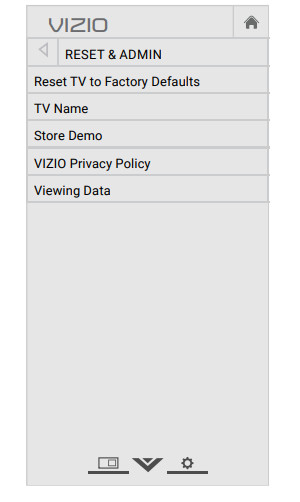
USING THE INFO WINDOW
The Info Window can be displayed by pressing the INFO or GUIDE button on the remote:
- Press the INFO or GUIDE button one time to display channel, input, and display information.
- Press the INFO or GUIDE button two times to display the program title, program rating, audio information, and the start and end times of the program. (Tuner Input only.)

Using the USB Media Player 4
Using the USB Media Player
The USB Media Player allows you to connect a USB thumb drive to your TV to view photos
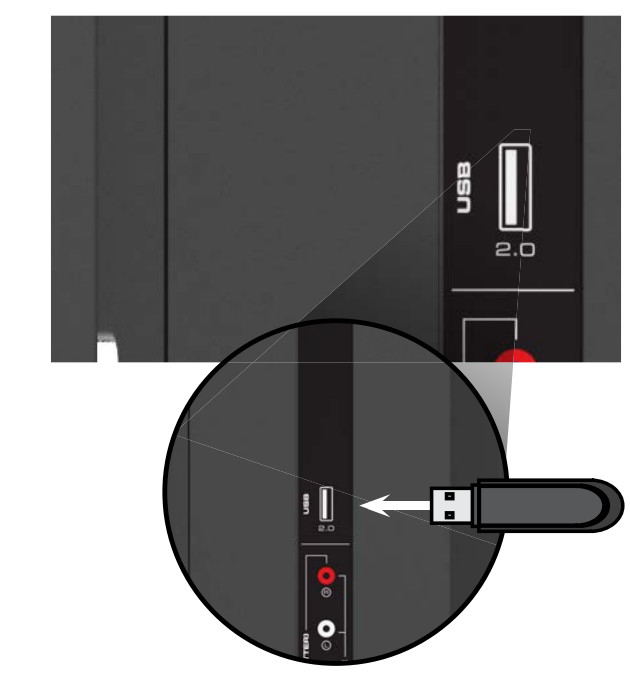
Preparing Your USB Drive to Play USB Media
To display USB media, you must first save your photos onto a USB thumb drive:
- The USB thumb drive must be formatted as FAT32.
- Files on the USB thumb drive must end in a supported file extension ( .jpg or .jpeg).
- The player is not designed to play media from external hard drives, MP3 players, cameras, or smartphones
Displaying USB Media
To display your USB media:
- Connect your USB thumb drive to the USB port on the side of the TV.
- Use the Arrow buttons to highlight the Yes and press OK. (The highlighted App is in the center of the dock.)
- Use the Arrow buttons to highlight the USB drive from the list and press OK.
- Use the Arrow buttons to highlight Photo and press OK.
- Use the Arrow buttons to highlight the file you want to display. Press OK. The photos display.
Removing the USB Drive from the TV
To safely remove your USB drive from the TV:
- Turn off the TV.
- Disconnect your USB thumb drive from the USB port on the side of the TV.
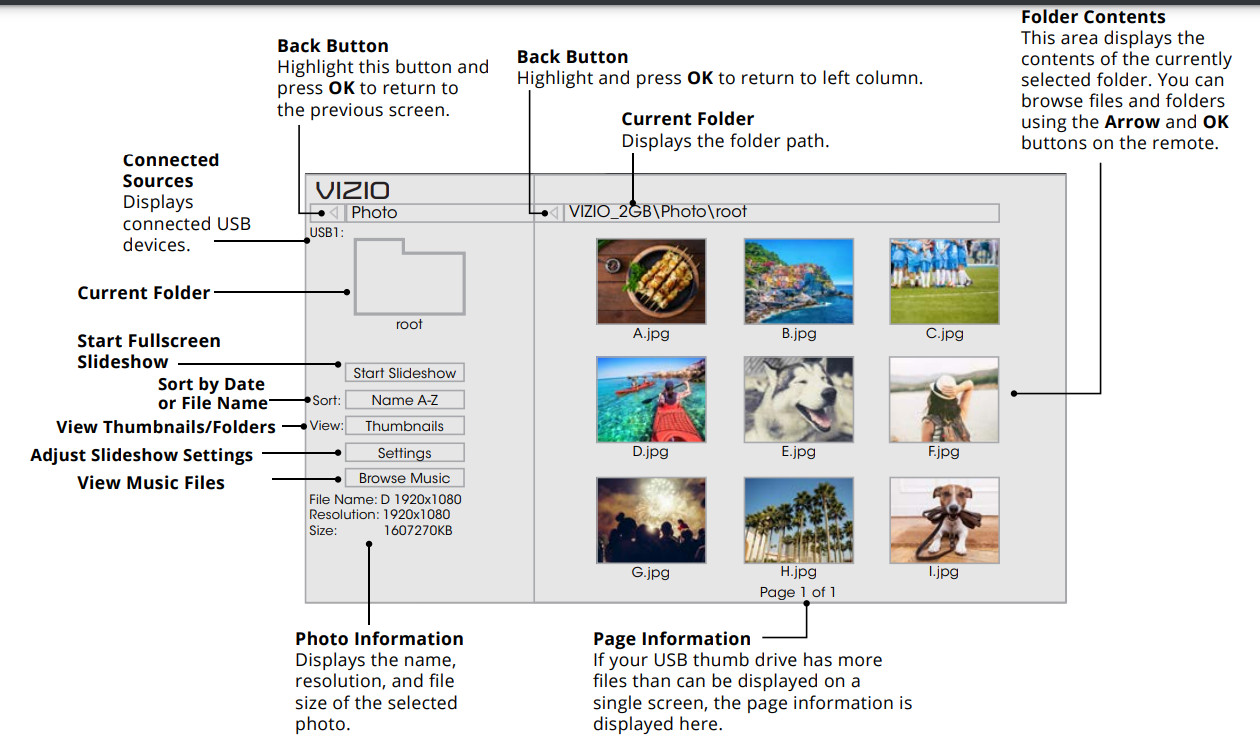
Troubleshooting
- The remote is not responding.
- Make sure the batteries are properly inserted matching the - and + symbols.
- Replace the batteries with fresh ones.
- The TV displays “No Signal.”
- Press the INPUT button on the remote control to select a different input source.
- If you are using cable TV or antenna connected directly to the TV, scan for channels. See Scanning for Channels on.
- There is no power.
- Ensure the TV is plugged into a working electrical outlet.
- Ensure the power cable is securely attached to the TV.
- Press the Power/Standby button on the remote or on the back of the TV to turn the TV on.
- The power is on, but there is no image on the screen.
- Ensure all cables are securely attached to the TV.
- (nsure all devices are connected correctly. Devices differ, see your device’s user manual for details.
- Adjust Brightness, Contrast, or Backlight. See Adjusting the Picture Settings.
- Press the INPUT button on the remote to select a different input source.
- There is no sound.
- Press Volume Up on the remote control.
- Press the MUTE button on the remote to ensure mute is off.
- Check the audio settings. See Adjusting the Audio Settings.
- Check the audio connections of external devices (Blu-ray player, game console, cable/satellite box) that are connected to the TV.
- If you are using an antenna, the signal strength of the channel may be low. Ensure your antenna is connected securely to the TV and move the antenna around the room or close to a window for the best signal.
- The sound is flat or dialog is not audible.
- Turn off Volume Leveling. See Adjusting the Audio Settings.
- The colors on the TV don't look right.
- Adjust the Color and Tint settings in the Picture menu. See Adjusting the Picture Settings.
- Select a pre-set picture mode. See Adjusting the Picture Settings. VIZIO recommends selecting Calibrated.
- Check all cables to ensure they are securely attached.
- The buttons on the remote aren't working.
- Ensure you are only pressing one button at a time.
- Point the remote directly at the TV when pressing a button.
- Replace the remote batteries with new ones. See Replacing the Batteries.
- The image quality is not good.
- For the best image quality, view high-definition programs using digital sources. Connect your devices with HDMI cables.
- If you are using an antenna, the signal strength of the channel may be low. Ensure your antenna is connected securely to the TV and move the antenna around the room or close to a window for the best signal.
- The picture is distorted.
- Move the TV away from electrical appliances, cars, and fluorescent lights.
- Ensure all cables are securely attached.
- The display image does not cover the entire screen.
- If you are using TV, AV, or Component with 480i input, press the
 button on the remote to change the screen mode.
button on the remote to change the screen mode.
- If you are using TV, AV, or Component with 480i input, press the
- The TV has pixels (dots) that are always dark.
- Your HD TV is precision-manufactured using an extremely high level of technology. However, sometimes pixels may not display correctly. These types of occurrences are inherent to this type of product and do not constitute a defective product.
- I see "noise" or static on the screen.
- When your TV's digital capabilities exceed a digital broadcast signal, the signal is up-converted (improved) to match your TV's display capabilities. This up-converting can sometimes cause irregularities in the image.
- If you are using an antenna, the signal strength of the channel may be low. Ensure your antenna is connected securely to the TV and move the antenna around the room or close to a window for the best signal.
- When I change input source, the display image changes size.
- The TV remembers the viewing mode on each input source. If the viewing mode on the new input source differs from the one on the input source you switch from, the difference may be noticeable.
- See Changing the Screen Aspect Ratio.
See other models: D39f-F0 E390i-B1E D39hn-E1 D500i-B1 D43f-F1
